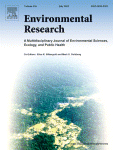Environmental Research 116
Overview of new articles on POPs in a new issue of the Environmental Research journal.

Pages 17-25
J.P. Arrebola, E. Mutch, M. Cuellar, M. Quevedo, E. Claure, L.M. Mejía, M. Fernández-Rodríguez, C. Freire, N. Olea, L.A. Mercado
- Multivariate models were used to predict serum and adipose tissue PCB concentrations.
- Fatty food consumption was related to both serum and adipose tissue concentrations.
- Serum concentrations were also predicted by occupation.
- Predictors of adipose tissue concentrations also included age, smoking and residence.
- BMI was an important modifier of the associations found.
Pages 36-43
Xabier Pontevedra-Pombal, Ledicia Rey-Salgueiro, Mercedes S. García-Falcón, Elena Martínez-Carballo, Jesús Simal-Gándara, Antonio Martínez-Cortizas
- The deposition of anthropogenic PAHs began earlier than industrial revolution.
- PAHs composition and other environmental proxies marked changes in sources.
- Anthropogenic fires cause accumulation of PAHs in the Middle Ages from local sources.
- Regional anthropogenic sources of PAHs increased from industrialisation.
Pages 74-84
Fred Parham, Amber Wise, Daniel A. Axelrad, Kathryn Z. Guyton, Christopher Portier, Lauren Zeise, R. Thomas Zoeller, Tracey J. Woodruff
- We model the relationship between PCBs and thyroid hormones in animals and humans.
- We compare dose–response for PBS and thyroid hormones between animals and humans.
- In animals, increasing PCBs are associated with decreasing thyroid hormones.
- In humans, increasing PCBs are generally associated with decreasing thyroid hormones.
- Estimated animal dose–response for PCB/thyroid underpredicts that in humans.
Pages 93-117
Gloria B. Post, Perry D. Cohn, Keith R. Cooper
- PFOA persists in the environment and has a long half-life in human serum.
- Drinking water can be an important source of human exposure to PFOA.
- Drinking water exposure to PFOA increases serum levels more in infants than adults.
- Low PFOA exposure is associated with many endpoints in humans; causality not proven.
- Mouse developmental effects occur at PFOA serum levels seen in some exposed humans.
1.6.2012




